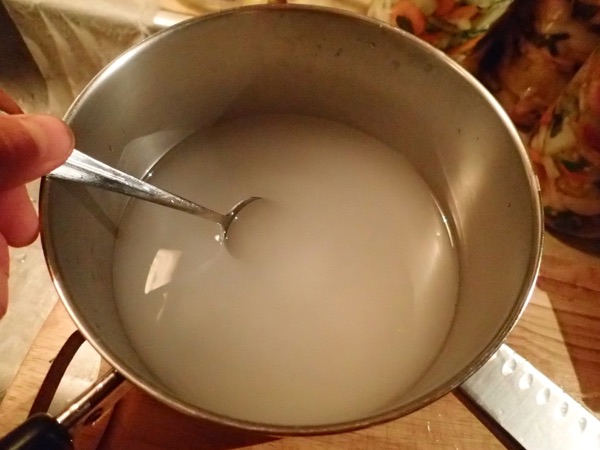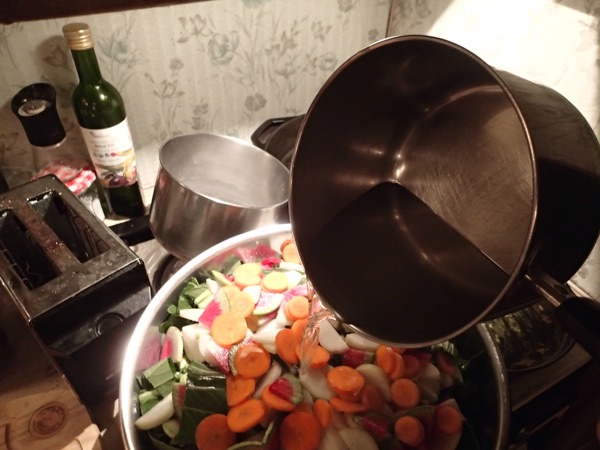Ready, set, ferment! This past season I made an effort to preserve more of the food we grow. I canned tomato sauce, pickled cucumbers & beets, dehydrated tomatoes, made sauerkraut, and made kimchi. The last one might be my favorite type of food preservation. It’s neat because it combines lots of vegetables and I like spicy food. Another cool thing about it is that it is lacto-fermented. Lacto-fermentation, is a process whereby one creates the conditions for the lactobacilli, a common beneficial bacteria, to thrive. Lactobacilli is one of the main live cultures in yogurt. Given the proper conditions, it preserves the food, and on top of that it happens to be very healthy. If you’re interested in learning more about lacto-fermentation I highly recommend the book Wild Fermentation by Sandor Katz.
Large Vegetable Ingredients
(these are the ones that soak in brine water overnight)
- 1 chinese cabbage (or bok choy), chopped
- 1 daikon radish, quartered & diced
- 1 watermelon radish, quartered & diced
- 1 carrot, sliced
- 5 cups of water
- 5 tablespoons of sea salt or non-iodized salt
Flavoring Vegetable Ingredients
(these are the ones that go into a container overnight)
- 1 medium sized onion, finely chopped
- 5 garlic cloves, minced
- 5 tbsp. fresh ginger, minced
- 1 or 2 hot thai peppers, minced. Include seeds for extra spice.
- freshly ground black pepper
- paprika
Preparation
1. Chop up all of your large vegetables and put them in a large bowl. Aren’t they pretty?

2. Mix the 5 tablespoons of salt with the 5 cups of water. This is your brine water. The brine water is what creates the conditions for lactobacilli to thrive. Pour the brine water over the vegetables.


3. Weigh down the veggies with a plate or something. Over time, they will reduce in size and be mostly covered by the brine. Set aside overnight.

4. Chop and mince the “flavoring vegetable ingredients”- onion, garlic, ginger, and hot peppers, and place in a tupperware or ceramic bowl. Grind black pepper over it and sprinkle some paprika on it. Cover and store in the fridge overnight.

5. In the morning, carefully pour out most of the brine water from the large bowl of vegetables. Save some of this brine water in case you need to add it to the kimchi jars at the end.
6. Stir in the flavoring vegetables. Mix well.
7. With clean hands or a spoon, stuff the mixture of vegetables into 2 quart jars. Use a wooden spoon or other kitchen implement to get as much of it into the jar as you can. The vegetables should have quite a bit of brine soaked into them. Press down the vegetables as much as possible so that they are covered with brine liquid. This is important because by now the lactobacilli from the air should have taken up residence in the brine, and in order to properly ferment, the vegetables should stay below the brine.

8. Cap the 2 quart jars and set on your counter top for about a week. The lactobacilli will get more and more active each day. It should bubble because it is releasing gas. Each day, and possibly more than once a day, you have to carefully crack open the lids to release the gas. Don’t worry if some of the brine sprays out. This is normal and it only means that the lactobacilli is doing its job. Each time I open the jars, I like to push the vegetables back down under the brine. Sometimes I’ll add extra brine water to ensure that the veggies stay covered. After about a week, the lactobacilli should have settled down and the kimchi should be relatively stable for storage. Store in a cool, dry place for weeks/months. You can put it on a shelf in your cellar or in the back of a cabinet. Or if you want, you can store it in the back of your refrigerator. Feel free to eat it right away. The flavors will evolve over time.
Enjoy the kimchi as a side dish or on an interesting sandwich.
For more information on lacto-fermentation check out Wild Fermentation

